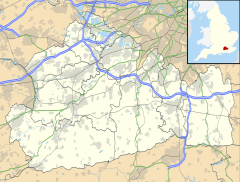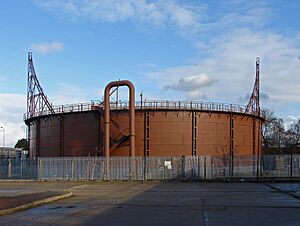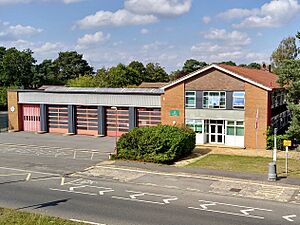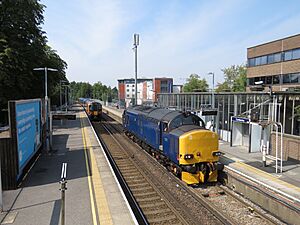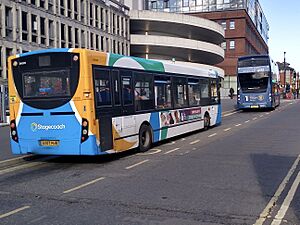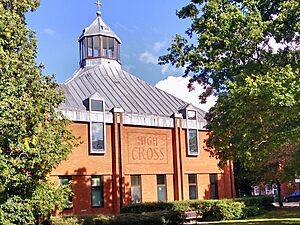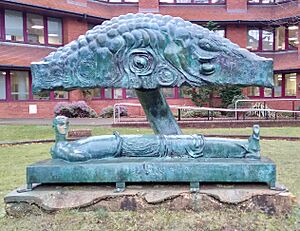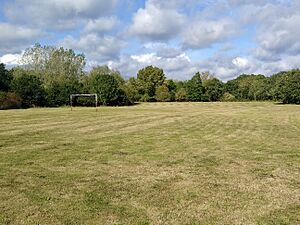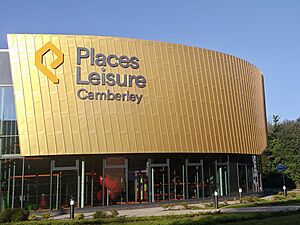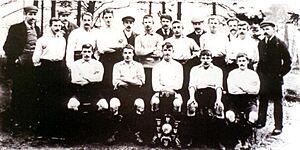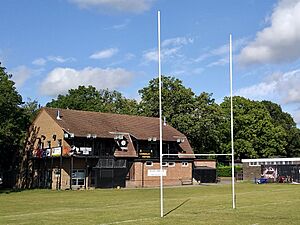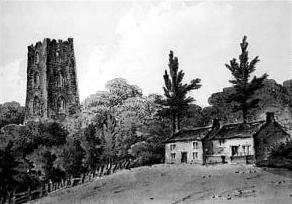Camberley facts for kids
Quick facts for kids Camberley |
|
|---|---|
| Town | |
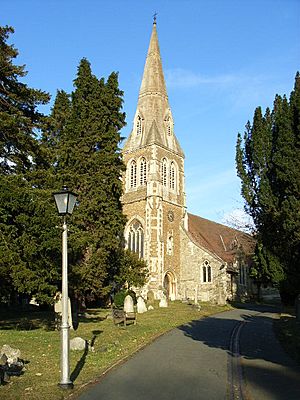 St Michael's Church, Camberley |
|
| Area | 16.78 km2 (6.48 sq mi) |
| Population | 36,783 [1] |
| • Density | 2,192/km2 (5,680/sq mi) |
| OS grid reference | TQ234561 |
| District |
|
| Shire county | |
| Region | |
| Country | England |
| Sovereign state | United Kingdom |
| Post town | Camberley |
| Postcode district | GU15, GU16 |
| Dialling code | 01276 |
| Police | Surrey |
| Fire | Surrey |
| Ambulance | South East Coast |
| EU Parliament | South East England |
| UK Parliament |
|
Camberley is a town in northwest Surrey, England. It is about 29 miles (47 km) southwest of central London. The town is part of the Borough of Surrey Heath. It is also close to the borders of Hampshire and Berkshire. Camberley was first called "Cambridge Town". It got its current name in 1877 from the General Post Office.
Before the 1800s, this area was mostly empty land. It was known as Bagshot or Frimley Heath. In 1812, the Royal Military College was built nearby. A small town called Yorktown grew up next to it. Later, in 1862, another army school, the Staff College, opened. This led to the creation of Cambridge Town. Over time, Yorktown and Cambridge Town grew together. Today, they are one big town. Many buildings in the town centre are quite new. For example, The Atrium, a place for shops, fun, and homes, opened in 2008.
Getting around the area became easier over time. The London to Basingstoke road, now the A30, opened in 1728. The Basingstoke Canal was finished in 1794. It helped bring building materials for the military college. Train stations also opened: Blackwater in 1849 and Camberley in 1878. In the late 1900s, new roads like the M3 motorway made travel even better.
Camberley has strong ties to the arts. The Camberley Theatre opened in 1966. The Elmhurst Ballet School was also in the town until 2004. Famous people who lived here include the composer Arthur Sullivan and musician Rick Wakeman. Actress Simone Ashley was born here in 1995. You can also find interesting public art in Camberley. One example is The Concrete Elephant, which was put up in 1964.
Contents
- What's in a Name? (Toponymy)
- Where is Camberley? (Geography)
- Camberley Through Time (History)
- Shops and Jobs (Economy)
- Town Services (Public Services)
- Getting Around (Transport)
- Learning in Camberley (Education)
- Churches and Other Faiths (Places of Worship)
- Fun and Art (Culture)
- Sports and Games (Sport)
- Important Buildings and Sights (Notable buildings and landmarks)
- Famous Faces (Notable people)
- Images for kids
- See also
What's in a Name? (Toponymy)
Camberley got its name on January 15, 1877. The General Post Office changed it from "Cambridge Town". This was to stop mail from going to Cambridge by mistake. The new name, Camberley, is a mix of three parts:
- "Cam" comes from a local stream.
- "Amber Hill" is an area of high ground. It was first noted in a map from 1607.
- "-ley" is a common ending in local place names like Frimley. It means "shelter" or "meadow" in Old English.
"Cambridge Town" was named after Prince George, Duke of Cambridge. He helped start the Staff College in 1859. Yorktown, to the west, was named after Prince Frederick, Duke of York and Albany. He approved the building of the Royal Military College in 1802. Both dukes were important army leaders.
Many street names in Camberley come from early landowners. Examples include Teckels Avenue and Stanhope Road. Watchetts Drive is named after a former field. Osnaburgh Parade is named after an estate linked to Prince Frederick.
Where is Camberley? (Geography)
Camberley is in the far west of Surrey. It is right next to the borders of Hampshire and Berkshire. The town is located between the A30 road and the M3 motorway. It is at the northern edge of the Blackwater Valley area. Camberley is about 5 miles (8 km) north of Farnborough. It is also 8 miles (13 km) south of Bracknell.
The land in Camberley is mostly sandy. It has layers of clay and areas with pebble gravel.
Camberley Through Time (History)
Before the 1800s, the area was known as Bagshot or Frimley Heath. An Iron Age fort, called Caesar's Camp, was to the north. Roman pottery has also been found here. In the Middle Ages, this area was part of Windsor Forest.
In the 1600s, the road through Bagshot Heath (now the A30) was famous for highwaymen. These were robbers who stopped travellers. The land was not good for farming because of its sandy soil. A writer named Daniel Defoe described it as "barren and sterile" in the 1720s. A brick tower, now called The Obelisk, was built on The Knoll in the 1770s. Its purpose is not fully known.
How Camberley Grew (19th Century)
The town we know today started with the building of the Royal Military College in 1812. This college later became the Royal Military Academy, Sandhurst. A settlement called "New Town" grew around the college. In 1831, it was renamed Yorktown. The population was 702 people then. In 1848, the first church, St. Michael's, was built in Yorktown.
Later, the Staff College was built east of the academy. A developer built the Cambridge Hotel nearby. Camberley grew even more when the railway and railway station arrived in 1878. The town also became known for its healthy air, thanks to many pine trees. People believed the air was good for lung problems. By the end of the 1800s, the population reached 8,400. Yorktown is now considered part of Camberley.
Modern Camberley (20th and 21st Centuries)
The first known motorcycle scrambling event happened on Camberley Heath in 1924. It was called the Southern Scott Scramble. Thousands of people watched it. This event is seen as the start of the sport of motocross. During the Second World War, the Old Dean common was used as a training camp for the Free French Forces.
The Old Dean housing estate was built in the 1950s. It provided homes for people from Surrey who lost their houses in the war. Many roads there are named after parts of London.
In 2006, a big new development called The Atrium was built. It has homes, shops, and places for fun. It also has large walking areas and parking. The Atrium opened in stages during 2008. The cinema and bowling alley opened in late 2008.
In 2009, homes in Camberley were found to have the highest carbon footprint in the UK. This means they used a lot of energy.
Shops and Jobs (Economy)
Camberley's town centre has The Square shopping centre. It was bought by Surrey Heath Borough Council in 2016. There are many shops on the High Street, as well as bars and clubs. Other shopping areas include Park Street and Princess Way. Like many towns, Camberley's town centre has seen fewer shoppers. This is because people now shop more online.
Big companies like Siemens have their UK headquarters here. Krispy Kreme UK is also based nearby in Frimley.
Town Services (Public Services)
Water, Gas, and Mail (Utilities)
The York Town and Blackwater Gas Company started in 1859. Gas street lamps were installed in Camberley from 1900. The gasworks closed in 1969.
Electricity came to the area in 1909. Camberley did not have its own power station. Instead, it bought electricity from other places.
The Frimley and Farnborough District Water Company began supplying water in 1897. Water was taken from underground and cleaned. Today, South East Water provides drinking water.
In the past, dirty water went into local streams. A drainage system was built in the 1880s. A new wastewater treatment plant opened in Yorktown in 1907. Now, Thames Water manages this.
The postal service started in Yorktown in 1844. Telephone service began in Camberley in 1897.
Police, Fire, and Health (Emergency Services and Healthcare)
The first police station opened in 1892. It moved in 1971 and then closed in 2011. Today, the closest police station is in Aldershot.
Camberley Fire Brigade started in 1889. It moved to its current station in London Road in 1967. Surrey Fire and Rescue Service now provides fire services.
An ambulance service started in Camberley in 1898. It first used horse-drawn vehicles. Today, the closest ambulance station is in Farnborough.
The nearest hospital is Frimley Park Hospital, about 1.4 miles (2.3 km) from Camberley. There are also three doctor's offices in town.
Getting Around (Transport)
Camberley railway station is south of the town centre. South Western Railway runs trains from here. You can go to Ascot and Aldershot. Journeys to London Waterloo are slow, taking about 70-80 minutes. Many people drive to other stations for faster trains. Blackwater railway station is west of Yorktown. Great Western Railway runs trains to Reading and Gatwick Airport.
Buses connect Camberley to nearby towns. These include Bracknell, Guildford, Aldershot, and Staines.
The M3 motorway runs south of Camberley. You can get on it at junction 4. The A30 road also runs through the town. The A331 Blackwater Valley relief road is another major route.
A new path for bikes and walkers was finished in 2017. It runs between Blackwater station and Watchmoor. A new bike parking area opened in Princess Way in 2021.
Learning in Camberley (Education)
Early Schools
The first school in Camberley opened in 1818. It was a National school. The composer Arthur Sullivan was one of its early students. By 1872, there was another school in Yorktown.
Cordwalles School moved to Camberley in 1910. It later merged with Kingswood School. It did not return to Camberley after the Second World War.
Barossa Secondary School started teaching in 1963. It was built on the Old Dean estate. Frimley and Camberley Grammar School opened in 1931.
Current Schools
Kings International College opened as France Hill Secondary School in 1947. It moved to its current spot in 1959. It changed its name to Kings International College in 2001.
Collingwood College was formed in 1971. It combined Camberley Grammar School, Barossa Secondary School, and Bagshot Secondary School.
The current Cordwalles School opened in 1962. It started as a primary and infants school. It became a junior school again in 1994.
Schools That Moved Away
The Royal Albert Orphan Asylum opened in Camberley in 1864. It was renamed the Royal Albert School in 1942. It later merged with another school to form The Royal Alexandra and Albert School. This new school moved to Gatton Park between 1948 and 1954. The old school buildings in Camberley were later torn down.
Elmhurst Ballet School started in 1923. It was based in Elmhurst House in Camberley. During the Second World War, other ballet schools joined Elmhurst here. The students performed for soldiers and raised money. The school grew and built a new theatre in 1960. It moved to Birmingham in 2004. The old school site in Camberley is now Elmhurst Court.
Churches and Other Faiths (Places of Worship)
Anglican Churches
St Michael's Church was designed by Henry Woodyer. It is built from local stone. The first stone was laid in 1848, and the church opened in 1851. It was expanded over the years. The tower was added in 1891. It has a tall spire that reaches 125 feet (38 m) high.
St Paul's Church was designed in 1902. It has a wooden spire. One of its stained-glass windows is for Doveton Sturdee. St Mary's Church opened in 1937. It is a smaller church built of brick.
St Martin's Church opened in 1978. Its building was partly paid for by selling the old St George's Church site.
Other Places of Worship
St Tarcisius Church was built from 1923 to 1926. It was a memorial to Catholic army officers who died in the First World War. It is made of stone.
High Cross Church opened in Knoll Road in 1990. It replaced two older churches that were torn down.
The local Bengali community opened an Islamic centre in 1996. Plans to build a new mosque were not approved by the council in 2010 and 2011.
Fun and Art (Culture)
Camberley Theatre opened in 1966. It closed for a big renovation in 1995 and reopened as Camberley ArtsLink. In 2001, it became Camberley Theatre again. It had another renovation in 2021.
Camberley has several public art pieces. The Concrete Elephant is near London Road. It was put up in 1964. The artist, Barbara Jones, designed it using parts from a company's products.
Into Our First World, a sculpture by Ken Ford, was put up in 1993. It shows a person lying under a tree. It represents the connection between people and nature. The Right Way, by Rick Kirby, was unveiled in 2009. It shows three metal figures pointing in different directions.
Sports and Games (Sport)
Places to Play (Venues)
The London Road Recreation Ground opened in 1898. Watchetts Recreation Ground opened in 1931.
Crabtree Park used to be a rubbish dump until the 1990s. It was cleaned up and reopened as a recreation ground. Its skate park was updated in 2014.
Camberley used to swim in the Blackwater River. The first swimming pool, the Blue Pool, opened in 1934. It closed in 1976 because it needed too many repairs.
The Arena Leisure Centre opened in 1984. It closed in 2019 and was rebuilt. The new Arena Leisure Centre opened in 2021. It has two swimming pools, a gym, and exercise studios.
Sports Teams (Organisations)
Camberley Town Football Club started around 1895. It was first part of the St Michael’s Club. The team played its first recorded match in 1896. It later became Camberley and Yorktown F. C.
The first cycling club in the area was recorded in 1889. By 1904, the Camberley Wheelers were active. In 1969, it merged to form the Farnborough & Camberley Cycling Club.
Camberley Rugby Football Club was founded in 1931. It played its first game at Watchetts Recreation Ground. Like many clubs, it stopped during the Second World War. It started again in 1947. The club built its own clubhouse in 1970.
Camberley Heath Golf Club opened in 1914. It was designed by Harry Colt. The course was used for the TV show Killing Eve in 2020.
There were two cricket teams in the 1860s, one for Yorktown and one for Cambridge Town. They merged in 1882 to form Camberley Cricket Club. The club stopped during the World Wars but restarted. The first girls' team was launched in 2013.
The first hockey club in Camberley formed in 1898. The current Camberley and Farnborough Hockey Club plays at Kings International College. There are also two tennis clubs: Camberley Lawn Tennis Club and Frimley Tennis Club.
Important Buildings and Sights (Notable buildings and landmarks)
The Camberley Obelisk is a brick tower at St Tarcisius School. Some say it was built around 1750-1770. Others say it was built around 1841. It was once 98 feet (30 m) tall, but only the bottom part remains. It might have been built for fun or for sending signals.
The Staff College is north of Camberley town centre. It is part of the Joint Services Command and Staff College. This college trains officers for the British Armed Forces. The Staff College building was designed in 1862. It is mostly made of brick.
The Camberley War Memorial was put up in 1922. It is at the entrance to the Royal Military Academy. It is a stone cross with the names of 233 people who died in the First World War. It also lists 140 people who died in the Second World War. A stone remembers Garth Walford, a local hero who died in 1915.
Famous Faces (Notable people)

- John Pennycuick (1841–1911) – an engineer who died in Camberley.
- Arthur Sullivan (1842–1900) – a famous composer. He lived in Camberley from age three to fifteen.
- Hosea Ballou Morse (1855–1934) – a historian of China. He lived in Camberley from 1914 until he died.
- Doveton Sturdee (1859–1925) – lived in Camberley.
- Vaughan Cornish (1862–1948) – a geographer who lived and died in Camberley.
- Frederick Twort (1877–1950) – a microbiologist. He was born, lived, and died in Camberley.
- Rick Wakeman (born 1949) – a musician. He lived in Camberley in the 1980s.
- George Saville (born 1993) – a footballer born in Camberley.
- Simone Ashley (born 1995) – an actress born in Camberley.
- Camberley Kate (1895–1979) – a dog lover and unique person who lived and died in Camberley.
Images for kids
See also
 In Spanish: Camberley para niños
In Spanish: Camberley para niños


